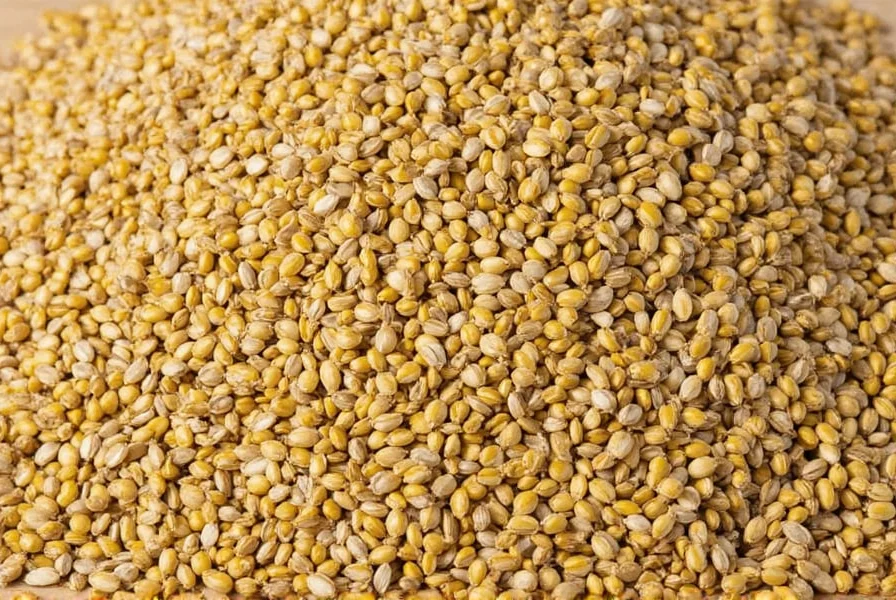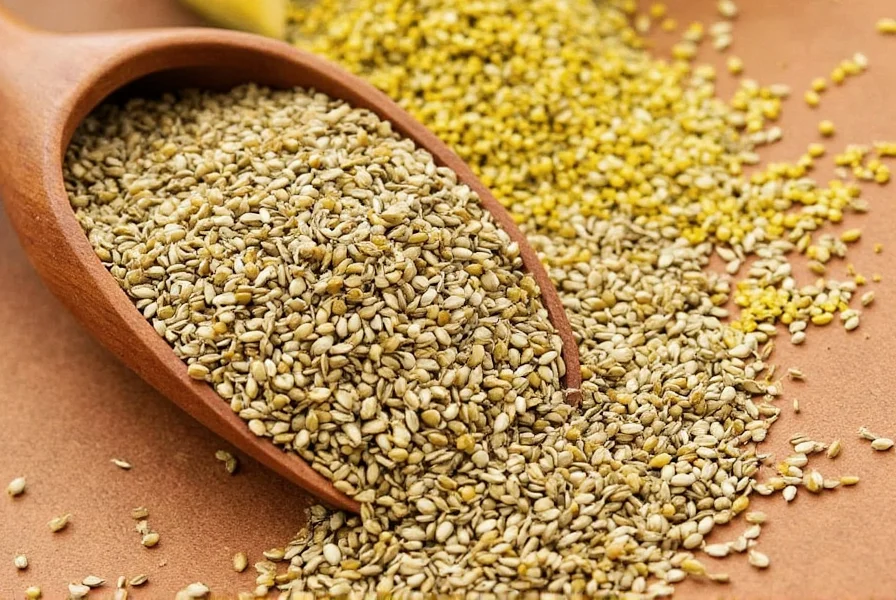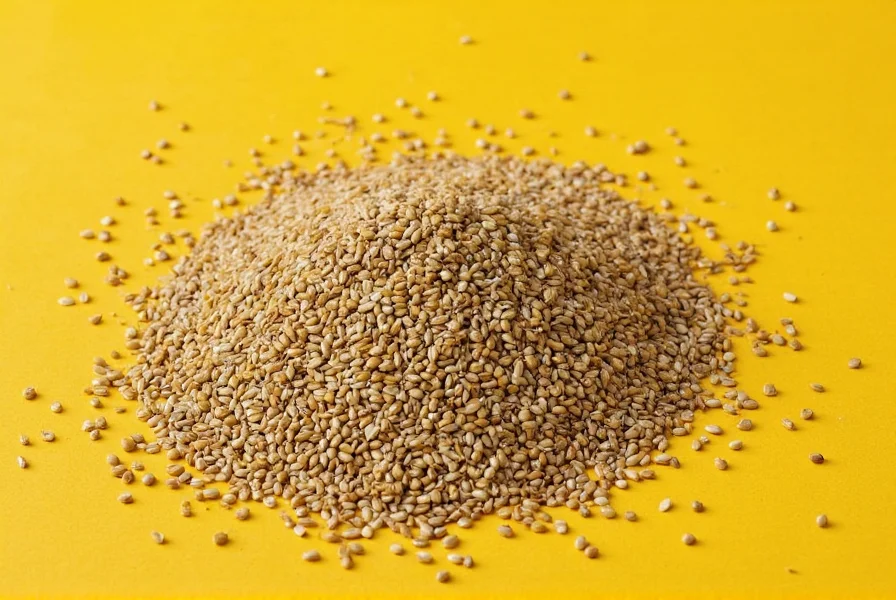These tiny powerhouses pack remarkable flavor and nutritional value. Measuring only 1-2 millimeters in diameter, mustard seeds transform dramatically when processed—releasing pungent compounds that create everything from mild table mustard to fiery condiments. Their chemical reaction when crushed with liquid (called enzymatic hydrolysis) produces the characteristic heat that dissipates with cooking, making them incredibly versatile in kitchen applications across Indian, European, and African cuisines.
Understanding Mustard Seed Varieties
Not all mustard seeds deliver the same experience. The three primary varieties differ significantly in flavor profile, heat level, and culinary applications:
| Variety | Color & Size | Flavor Profile | Common Uses |
|---|---|---|---|
| Yellow/White | Pale yellow, 2mm | Mildest, slightly tangy | American yellow mustard, pickling, salad dressings |
| Brown | Reddish-brown, 1.5mm | Moderately hot, complex | Dijon mustard, Indian curries, spice blends |
| Black | Dark brown/black, 1mm | Most pungent, intensely spicy | South Indian cooking, Ethiopian spices, traditional medicines |
Culinary Transformations: From Seed to Sensation
The magic of mustard seeds happens through preparation. When whole seeds hit hot oil, they pop like miniature popcorn, releasing nutty aromas perfect for tempering dishes. Crushed seeds mixed with acidic liquids (vinegar, wine, or lemon juice) create that familiar sharp heat through a chemical reaction that produces allyl isothiocyanate. This compound—also found in horseradish—explains why mustard's heat differs from chili peppers' capsaicin burn.
Chefs worldwide leverage these properties strategically. Indian cooks often add whole mustard seeds at the beginning of cooking for subtle flavor, while French producers ferment brown seeds with verjuice for Dijon's distinctive sharpness. The Japanese condiment karashi uses pungent black seeds for its intense heat, demonstrating how cultural techniques maximize each variety's potential.
Nutritional Powerhouse: Beyond the Heat
Mustard seeds deliver impressive nutritional benefits beyond their flavor contribution. A single tablespoon (9g) provides:
- Approximately 50 calories with 3g of healthy fats
- 3g of plant-based protein
- 2g of dietary fiber supporting digestive health
- Significant selenium (23% of daily value) for thyroid function
- Calcium and magnesium for bone health
- Antioxidants like quercetin and kaempferol
Research published in the Journal of Food Science and Technology indicates that mustard seeds' glucosinolates may offer anti-inflammatory benefits and support cardiovascular health. Their natural compounds show potential in blood sugar regulation, making them particularly valuable in traditional Ayurvedic and Chinese medicine practices.

Growing Your Own Mustard Seeds
Cultivating mustard plants requires minimal space and effort, making them ideal for home gardeners. The Brassica family grows quickly in most temperate climates, reaching maturity in 80-95 days from seed. For optimal seed production:
- Plant seeds 1/4 inch deep in well-draining soil after last frost
- Maintain consistent moisture during germination (5-7 days)
- Thin seedlings to 6-8 inches apart for mature growth
- Allow pods to dry completely on plant before harvesting
- Store seeds in airtight containers away from light and moisture
Mustard plants serve dual purposes in gardens—their vibrant yellow flowers attract pollinators while the mature plants suppress weeds and improve soil quality as green manure. Many organic farmers use mustard as a cover crop to combat soil-borne pathogens through biofumigation.
Practical Kitchen Applications
Understanding how to work with mustard seeds elevates everyday cooking. For authentic Indian tadka (tempering), heat oil until shimmering, add seeds, and cover immediately—they pop violently! Wait until popping slows before adding other spices. For homemade mustard, soak seeds 12-24 hours before blending with vinegar and flavorings; longer soaking creates milder mustard.
Professional chefs recommend toasting whole seeds in a dry pan for 2-3 minutes until fragrant before grinding—this enhances their nutty flavor without bitterness. Mustard seeds pair exceptionally well with turmeric, cumin, and fenugreek in spice blends, while their natural preservative qualities make them ideal for pickling vegetables.

Storage and Shelf Life Considerations
Proper storage maintains mustard seeds' potency and prevents rancidity. Whole seeds retain freshness for 3-4 years when stored in airtight containers away from light and heat. Once ground, their surface area increases dramatically, causing volatile compounds to degrade within 6-12 months. For maximum flavor retention:
- Store whole seeds in glass jars with tight-fitting lids
- Keep containers in cool, dark pantry locations (below 70°F/21°C)
- Avoid humidity which causes premature sprouting
- Refrigerate ground mustard for extended shelf life
- Check for musty odors indicating spoilage
Commercial producers often vacuum-seal mustard seeds with oxygen absorbers for maximum longevity. Home cooks can freeze seeds for long-term storage without flavor degradation—simply allow to reach room temperature before opening containers to prevent condensation.
Frequently Asked Questions
What's the difference between yellow and brown mustard seeds?
Yellow/white mustard seeds (Sinapis alba) are largest and mildest, creating the familiar bright yellow American mustard. Brown seeds (Brassica juncea) are smaller, darker, and significantly hotter with complex flavors ideal for Dijon and Indian cooking. Brown seeds contain more sinigrin—the compound responsible for pungency—making them approximately 3-4 times hotter than yellow varieties.
Can mustard seeds help with digestion?
Yes, mustard seeds have been used traditionally to support digestion. They stimulate saliva and gastric juice production through their pungent compounds. The fiber content (3g per tablespoon) aids regularity, while certain compounds may help reduce intestinal gas. Many Ayurvedic preparations include mustard seeds specifically for digestive complaints, though scientific research remains limited to preliminary studies.
Why do mustard seeds pop when heated in oil?
Mustard seeds contain approximately 20-30% moisture content. When exposed to hot oil (typically above 300°F/150°C), this moisture instantly vaporizes, creating steam pressure that ruptures the seed coat. The sudden expansion causes the characteristic popping sound and visual jump. This process, called “fracturing,” releases essential oils and begins the enzymatic reaction that develops mustard's flavor compounds.
Mustard seeds contain approximately 20-30% moisture content. When exposed to hot oil (typically above 300°F/150°C), this moisture instantly vaporizes, creating steam pressure that ruptures the seed coat. The sudden expansion causes the characteristic popping sound and visual jump. This process, called “fracturing,” releases essential oils and begins the enzymatic reaction that develops mustard's flavor compounds.
Are mustard seeds safe for people with thyroid conditions?
Mustard seeds contain goitrogens that may interfere with thyroid function in sensitive individuals when consumed in extremely large quantities. However, typical culinary use (1-2 teaspoons daily) poses minimal risk for most people. Those with diagnosed thyroid conditions should consult their healthcare provider, but moderate consumption as part of a balanced diet generally presents no significant concerns according to current nutritional research.
How can I make mustard seeds less spicy?
To reduce mustard seed heat, use yellow varieties instead of brown or black. Soaking seeds in warm liquid (vinegar, wine, or water) for 12-24 hours before processing significantly mutes the pungency by allowing enzymes to break down. Adding acidic components like lemon juice or vinegar during preparation also tempers the heat. Cooking mustard seeds thoroughly—rather than using them raw—converts the sharp compounds into milder flavors through thermal degradation.











 浙公网安备
33010002000092号
浙公网安备
33010002000092号 浙B2-20120091-4
浙B2-20120091-4